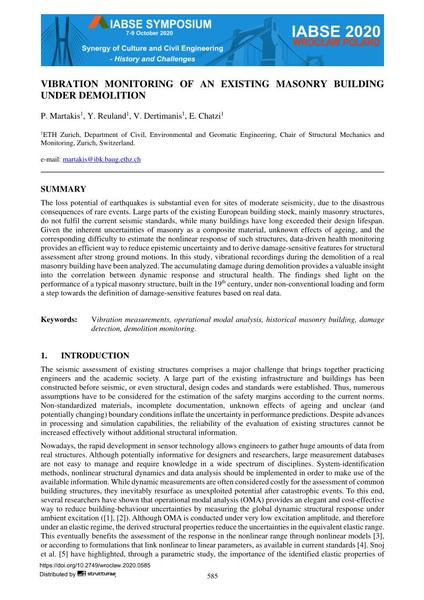Vibration Monitoring of an Existing Masonry Building Under Demolition

|
|
|||||||||||
Détails bibliographiques
| Auteur(s): |
P. Martakis
Y. Reuland V. Dertimanis E. Chatzi |
||||
|---|---|---|---|---|---|
| Médium: | papier de conférence | ||||
| Langue(s): | anglais | ||||
| Conférence: | IABSE Symposium: Synergy of Culture and Civil Engineering – History and Challenges, Wrocław, Poland, 7-9 October 2020 | ||||
| Publié dans: | IABSE Symposium Wroclaw 2020 | ||||
|
|||||
| Page(s): | 585-592 | ||||
| Nombre total de pages (du PDF): | 8 | ||||
| Année: | 2020 | ||||
| DOI: | 10.2749/wroclaw.2020.0585 | ||||
| Abstrait: |
The loss potential of earthquakes is substantial even for sites of moderate seismicity, due to the disastrous consequences of rare events. Large parts of the existing European building stock, mainly masonry structures, do not fulfil the current seismic standards, while many buildings have long exceeded their design lifespan. Given the inherent uncertainties of masonry as a composite material, unknown effects of ageing, and the corresponding difficulty to estimate the nonlinear response of such structures, data-driven health monitoring provides an efficient way to reduce epistemic uncertainty and to derive damage-sensitive features for structural assessment after strong ground motions. In this study, vibrational recordings during the demolition of a real masonry building have been analyzed. The accumulating damage during demolition provides a valuable insight into the correlation between dynamic response and structural health. The findings shed light on the performance of a typical masonry structure, built in the 19th century, under non-conventional loading and form a step towards the definition of damage-sensitive features based on real data. |
||||
